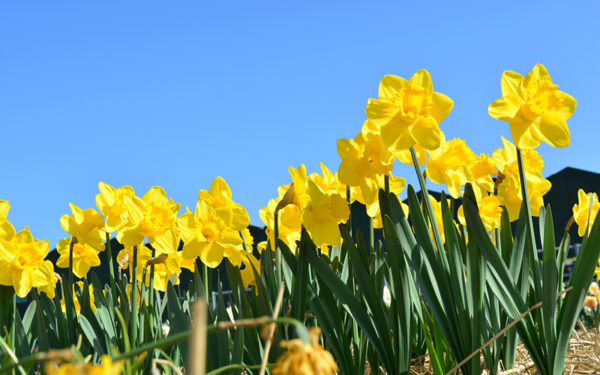Daffodil Planting Instructions
- You do not require a large space to plant the bulbs.
- For every 250 bulbs, you will need approximately 30 square feet in any combination.
- Plant the daffodils 3-4 inches deep and 2-3 inches apart.
- Plant approximately 7-10 bulbs in a 1 foot circle with 1-3 bulbs in the center.
- Wait until all bulbs have been planted prior to covering with soil and then mulching.
- Once you have planted, mulch and water the bed. There is very little further maintenance.
- Once the daffodils bloom, they should be left to yellow and wither (otherwise they will not be able to produce flowers the following year). Dead-heading is recommended for the best re-flowering but is not required. Fertilizer is not needed if you mulch your bulbs annually with 2-3 inches of an organic mulch.
Picture Books
(Elementary School Level or a good introduction for older students)
Terrible Things: An Allegory of the Holocaust by Eve Bunting
Promise of a New Spring by Gerta Weissman Klein
The Grand Mosque of Paris: A Story of how Muslims Rescued Jews During the Holocaust by Karen Gray Ruelle
One Yellow Daffodil: A Hanukkah Story by David A. Adler
One Candle by Eve Bunting
Marcel Marceau: Master of Mine by Gloria Spielman
The Feather-Bed Journey by Paula Kurzband Feder
The Journey That Saved Curious George: The True Wartime Escape of Margret and H.A. Rey by Louise W. Borden
Keeping the Promise: A Torah’s Journey by Tami Lehman-Wilzig
Six Million Paper Clips: The Making of a Children’s Holocaust Memorial by Peter W. Schroeder
I Never Saw Another Butterfly: Children’s Drawings and Poems from the Terezin Concentration Camp, 1942-1944 by Hana Volavková
The Yellow Star: The Legend of Christian X of Denmark by Caren Agra Deedy
Chapter Books
(Upper Elementary School/ Middle School)
When Hitler Stole the Pink Rabbit by Judith Kerr
Number the Stars by Lois Lowry
I Survived the Nazi Invasion by Lauren Tarshis
The Upstairs Room by Johanna Reiss
Survivors: True Stories of Children in the Holocaust by Allan Zullo
Milkweed by Jerry Spinelli
Who Was Anne Frank? by Ann Abramson
(Higher Middle School Level/High School)
Friedrich by Hans P. Richter
Sarah’s Key by Tatiana de Rosney
The Diary of a Young Girl by Anne Frank
Maus I and Maus II by Art Spiegelman
We Are Witnesses: Five Diaries of Teenagers Who Died in the Holocaust by Jacob Boas
Films
(4th and 5th grade and up)
The Number on My Great Grandpa’s Arm
BrainPop
(Middle School age and up)
Centropa Films (variety)
Eva Kor: The Holocaust survivor who forgave the Nazis | BBC Ideas – Bing video
Project 1938
Holocaust Survivors Remember Kristallnacht
Activities
Elementary School age and up – Open with a question: “What would you do” in the shoes of someone persecuted for their faith?
Middle School age and up
- Take the Holocaust Questionnaire to help students gain context and perspective on the events that took place starting from just before 1933 to events that took place after 1945.
- Brain Pop and Daniel’s Story (from United States Holocaust Museum) are good ways to introduce the Holocaust.
Teens, Young Adults, and Adults
Read the poem Take This Giant Leap by Sonia Weitz and answer attached questions.

